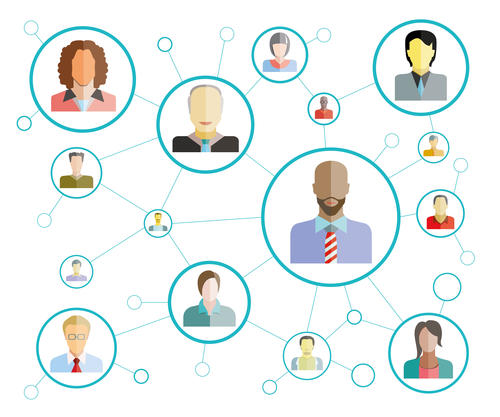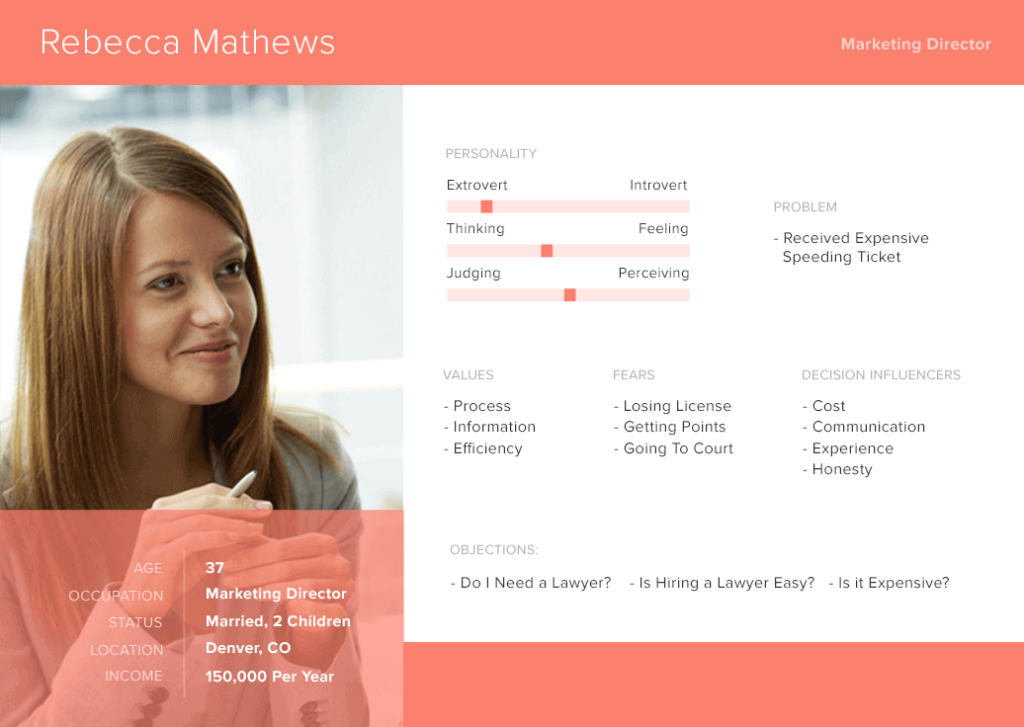Effective legal marketing starts with strategy. A strong foundation provides a platform from which you can build and manage campaigns. Creating client personas is an important part of the planning process. Personas will help you target and refine your marketing efforts to maximize ROI. By identifying the common traits of the people that need your services, you’ll avoid wasting marketing spend.
What is a Client (Buyer) Persona?
 Not sure what a client persona is? Don’t worry – it’s simple:
Not sure what a client persona is? Don’t worry – it’s simple:
A client persona, commonly referred to as a customer or buyer persona, is a semi-fictional profile used to represent your ideal client. The persona aims to define targeted demographics, attitudes towards services, behaviors, objections, and other essential information.
Does My Firm Really Need Personas?
To put it bluntly – yes. Legal marketing is intensely competitive. The bigger your market, the tougher it is to create and execute effective marketing strategies. In recent years digital marketing has made competition tougher. It’s also made personas more important. The ability to identify the typical buyer’s journey and adjust strategy accordingly is crucial. A client persona will aid immensely in those efforts.
How Do You a Create a Client Persona?
You’re on board. It’s time to create client personas and tweak your digital marketing strategy. But where do you start?
Right here on the Juris blog, of course. We’ve got all the info you need to create client personas today. Check it out:
Step 1 – Use Existing Data
Start by reviewing existing client profiles. Look for trends. Common age range? Similar occupations? Where do they live? Work? How did they find out about your firm? What motivated them to seek your services? Record all information that might be relevant for your client personas.
Step 2 – Use Your Website
Your website is the most powerful marketing tool you possess if used correctly. Contact forms are an excellent opportunity to capture information relevant to client personas. For example, you might ask for a potential client’s location in addition to other standard information.
Analytics information can also be relevant to client personas. Do most of your clients find your firm through organic search, or are they using other methods? What type of device do potential clients usually browse your site with? This information, along with other KPIs, can be especially helpful in building personas.
Step 3 – Talk to Your Clients
Using existing client profiles and your website can help with a hefty portion of your client personas, but key information will still be missing. Talking to past and current clients is a great way to fill the gaps. You can ask pertinent questions that will provide enlightening answers.
For example, you can inquire about your client’s biggest objections when considering various legal providers. You can also ask about hobbies, interests, fears, and their end goals in hiring you.
Here are a few tips for recruiting interviewees:
- Talk to Good and “Bad” Clients – You want an accurate sampling of information, so it’s important that you don’t only reach out to clients who had a great experience. Don’t be afraid to reach out to a client who expressed frustration with your process or left a bad review. Use it as an opportunity to learn from the experience.
- Offer a Bonus – What’s better than a gift card to a great restaurant? Offer clients a bonus to give you a half hour or so of their time for an interview. People are busy and they are more likely to pay attention when they get something in return for their time. Use that to your advantage. Incentives can also be used to get interviews with those in your market, but who haven’t used your services in the past.
- Interview as Many People as Possible – The more information you can gather the better. If your goal is to build 3 or 4 different personas, 20 interviews is a good target to shoot for. A larger sampling of data will only give you more accurate personas.
Step 4 – Build Client Personas

Now that you’ve gathered the data it’s time to build the profiles. Start by outlining the information that each persona will include. Check out the list below to see some of my recommended persona details. After you’ve got your outlines, can you give each profile a name and start to complete the information. Keep in mind that you may have some commonalities between personas, and that’s totally fine.
Sifting through this much data can be tough, so I recommend using a tool like Microsoft Excel to organize the information.
Essential Client Persona Details
Client personas differ based on the type of law you practice, your location, and other factors. However, we’ve put together a list with some essential details that shouldn’t be left out:
- Demographic information, including age, location, sex, income, household type.
- Background information such as family, occupation, experience.
- Why they need your service.
- Objections
- Motivators
- Values
TL;DR – Client personas are essential to effective marketing. They are profiles of ideal clients, and they can be created by using existing data and talking to past, current, and future clients.
If you like to discuss personas further or talk about SEO and digital marketing as a whole, we’d love to chat. Reach out today!
